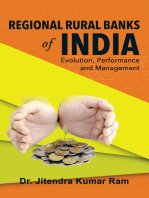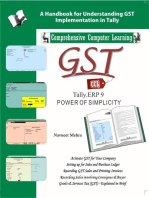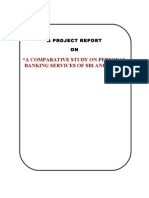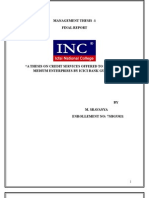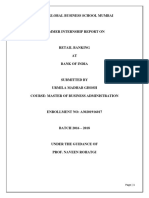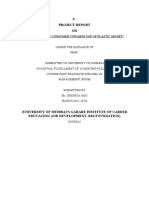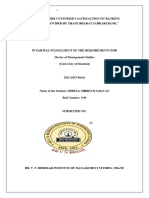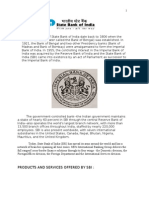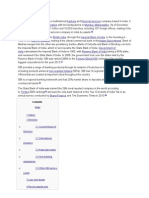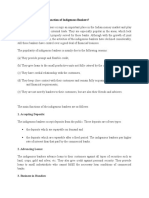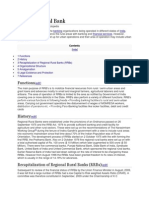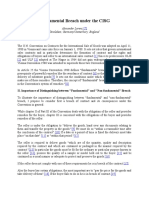History: State Bank of India (SBI) Is A Multinational
History: State Bank of India (SBI) Is A Multinational
Uploaded by
srikanthuasCopyright:
Available Formats
History: State Bank of India (SBI) Is A Multinational
History: State Bank of India (SBI) Is A Multinational
Uploaded by
srikanthuasOriginal Description:
Original Title
Copyright
Available Formats
Share this document
Did you find this document useful?
Is this content inappropriate?
Copyright:
Available Formats
History: State Bank of India (SBI) Is A Multinational
History: State Bank of India (SBI) Is A Multinational
Uploaded by
srikanthuasCopyright:
Available Formats
State Bank of India (SBI) is a multinational banking and financial services company based in India.
It is
a government-owned corporation with its headquarters in Mumbai, Maharashtra. As of December 2013, it had assets
of US$388 billion and 17,000 branches, including 190 foreign offices, making it the largest banking and financial
services company in India by assets.
[3][4]
State Bank of India is one of the Big Four banks of India, along with ICICI Bank, Punjab National Bank and HDFC
Bank.
The bank traces its ancestry to British India, through the Imperial Bank of India, to the founding, in 1806, of the Bank
of Calcutta, making it the oldest commercial bank in the Indian Subcontinent. Bank of Madras merged into the other
two "presidency banks" in British India, Bank of Calcutta and Bank of Bombay, to form the Imperial Bank of India,
which in turn became the State Bank of India. Government of India owned the Imperial Bank of India in 1955,
with Reserve Bank of India (India's Central Bank) taking a 60% stake, and renamed it the State Bank of India. In
2008, the government took over the stake held by the Reserve Bank of India.
State Bank of India is a regional banking behemoth and has 20% market share in deposits and loans among Indian
commercial banks.
[5]
Contents
[hide]
1 History
2 Operations
o 2.1 Domestic presence
o 2.2 International presence
o 2.3 Associate banks
o 2.4 Non-banking subsidiaries
o 2.5 Other SBI service points
3 Logo and slogan
4 Listings and shareholding
5 Employees
6 Recent awards and recognitions
7 Major competitors
8 References
9 External links
History[edit]
Seal of Imperial Bank of India.
The roots of the State Bank of India lie in the first decade of the 19th century, when the Bank of Calcutta, later
renamed the Bank of Bengal, was established on 2 June 1806. The Bank of Bengal was one of three Presidency
banks, the other two being the Bank of Bombay(incorporated on 15 April 1840) and the Bank of Madras (incorporated
on 1 July 1843). All three Presidency banks were incorporated asjoint stock companies and were the result of royal
charters. These three banks received the exclusive right to issue paper currency till 1861 when, with the Paper
Currency Act, the right was taken over by the Government of India. The Presidency banks amalgamated on 27
January 1921, and the re-organised banking entity took as its name Imperial Bank of India. The Imperial Bank of
India remained a joint stock company but without Government participation.
Pursuant to the provisions of the State Bank of India Act of 1955, the Reserve Bank of India, which is India's central
bank, acquired a controlling interest in the Imperial Bank of India. On 1 July 1955, the Imperial Bank of India became
the State Bank of India. In 2008, thegovernment of India acquired the Reserve Bank of India's stake in SBI so as to
remove any conflict of interest because the RBI is the country's banking regulatory authority.
In 1959, the government passed the State Bank of India (Subsidiary Banks) Act, which made eight state banks
associates of SBI. A process of consolidation began on 13 September 2008, when the State Bank of
Saurashtra merged with SBI.
SBI has acquired local banks in rescues. The first was the Bank of Bihar (est. 1911), which SBI acquired in 1969,
together with its 28 branches. The next year SBI acquired National Bank of Lahore (est. 1942), which had 24
branches. Five years later, in 1975, SBI acquired Krishnaram Baldeo Bank, which had been established in 1916
in Gwalior State, under the patronage of Maharaja Madho Rao Scindia. The bank had been the Dukan Pichadi, a
small moneylender, owned by the Maharaja. The new bank's first manager was Jall N. Broacha, a Parsi. In 1985, SBI
acquired the Bank of Cochin in Kerala, which had 120 branches. SBI was the acquirer as its affiliate, the State Bank
of Travancore, already had an extensive network in Kerala.
The State Bank of India and all its associate banks are identified by the same blue keyhole logo. The State Bank of
India wordmark usually has one standard typeface, but also utilises other typefaces.
On October 7, 2013, Arundhati Bhattacharya became the first woman to be appointed Chairperson of the bank.
[6]
Operations[edit]
SBI provides a range of banking products through its network of branches in India and overseas, including products
aimed at non-resident Indians (NRIs). SBI has 14 regional hubs and 57 Zonal Offices that are located at important
cities throughout India.
Domestic presence[edit]
SBI has 14,816 branches in India, as on 31 March 2013, of which 9,851 (66%) were in Rural and Semi-urban
areas.
[1]
In the financial year 2012-13, its revenue was INR 200,560 Crores (US$ 36.9 billion), out of which domestic
operations contributed to 95.35% of revenue. Similarly, domestic operations contributed to 88.37% of total profits for
the same financial year.
[1]
International presence[edit]
The Israeli branch of the State Bank of India located in Ramat Gan.
As of 28 June 2013, the bank had 180 overseas offices spread over 34 countries. It has branches of the parent
in Moscow, Colombo,Dhaka, Frankfurt, Hong Kong, Tehran, Johannesburg, London, Los Angeles, Male in
the Maldives, Muscat, Dubai, New York, Osaka, Sydney, and Tokyo. It has offshore banking units in the Bahamas,
Bahrain, and Singapore, and representative offices in Bhutan and Cape Town. It also has an ADB in Boston, USA.
The Canadian subsidiary, State Bank of India (Canada) also dates to 1982. It has seven branches, four in
the Toronto area and three in the Vancouver area.
SBI operates several foreign subsidiaries or affiliates. In 1990, it established an offshore bank: State Bank of India
(Mauritius). SBI (Mauritius) has 15 branches in major cities/towns of the country including Rodrigues.
State Bank of India Branch at Jaffna,Sri Lanka
SBI Sri Lanka, Oldest Bank in Sri Lanka now has three branches located in Colombo, Kandy and Jaffna. The 3rd
branch was opened inJaffna, Northern Province on 09th September 2013. On 1st July 2014 SBI Sri Lanka celebrated
their 150th year presence in Sri Lanka.
State Bank of India (S.B.I.) Branch at Tsim Sha Tsui, Hong Kong
In 1982, the bank established a subsidiary, State Bank of India (California), which now has ten branches nine
branches in the state of California and one in Washington, D.C. The 10th branch was opened in Fremont, California
on 28 March 2011. The other eight branches in California are located in Los Angeles, Artesia, San Jose, Canoga
Park, Fresno, San Diego, Tustin and Bakersfield.
In Nigeria, SBI operates as INMB Bank. This bank began in 1981 as the Indo-Nigerian Merchant Bank and received
permission in 2002 to commence retail banking. It now has five branches in Nigeria.
In Nepal, SBI owns 55% of Nepal SBI Bank, which has branches throughout the country. In Moscow, SBI owns 60%
of Commercial Bank of India, with Canara Bank owning the rest. In Indonesia, it owns 76% of PT Bank Indo Monex.
The State Bank of India already has a branch in Shanghai and plans to open one in Tianjin.
[7]
In Kenya, State Bank of India owns 76% of Giro Commercial Bank, which it acquired for US$8 million in October
2005.
[8]
Associate banks[edit]
Main Branch of SBI in Mumbai.
SBI has five associate banks; all use the State Bank of India logo, which is a blue circle, and all use the "State Bank
of" name, followed by the regional headquarters' name:
State Bank of Bikaner & Jaipur
State Bank of Hyderabad
State Bank of Mysore
State Bank of Patiala
State Bank of Travancore
Earlier SBI had seven associate banks, all of which had belonged to princely states until the government nationalised
them between October 1959 and May 1960. In tune with the first Five Year Plan, which prioritised the development of
rural India, the government integrated these banks into State Bank of India system to expand its rural outreach. There
has been a proposal to merge all the associate banks into SBI to create a "mega bank" and streamline the group's
operations.
[9]
The first step towards unification occurred on 13 August 2008 when State Bank of Saurashtra merged with SBI,
reducing the number of associate state banks from seven to six. Then on 19 June 2009 the SBI board approved the
absorption of State Bank of Indore. SBI holds 98.3% in State Bank of Indore. (Individuals who held the shares prior to
its takeover by the government hold the balance of 1.77%.)
[10]
The acquisition of State Bank of Indore added 470 branches to SBI's existing network of branches. Also, following the
acquisition, SBI's total assets will inch very close to the 10 trillion mark (10 billion long scale). The total assets of
SBI and the State Bank of Indore stood at 9,981,190 million as of March 2009. The process of merging of State
Bank of Indore was completed by April 2010, and the SBI Indore branches started functioning as SBI branches on 26
August 2010.
[11]
State Bank of India Mumbai LHO.
Non-banking subsidiaries[edit]
Apart from its five associate banks, SBI also has the following non-banking subsidiaries:
SBI Capital Markets Ltd
SBI Funds Management Pvt Ltd
SBI Factors & Commercial Services Pvt Ltd
SBI Cards & Payments Services Pvt. Ltd. (SBICPSL)
SBI DFHI Ltd
SBI Life Insurance Company Limited
SBI General Insurance
In March 2001, SBI (with 74% of the total capital), joined with BNP Paribas (with 26% of the remaining capital), to
form a joint venture life insurance company named SBI Life Insurance company Ltd. In 2004, SBI DFHI (Discount and
Finance House of India) was founded with its headquarters in Mumbai.
Other SBI service points[edit]
As of 31 March 2014: SBI has 43,515 ATMs and SBI group (including associate banks) has 51,491 ATMs. SBI has
become the first bank to install an ATM at Drass in the Jammu & Kashmir Kargil region. This was the Bank's
27,032nd ATM on 27 July 2012.
Logo and slogan[edit]
The logo of the State Bank of India is a blue circle with a small cut in the bottom that depicts perfection and the
small man the common man - being the center of the bank's business. The logo came from National Institute of
Design(NID), Ahmedabad and it was inspired by Kankaria Lake, Ahmedabad.
[12]
Slogans: "PURE BANKING, NOTHING ELSE", "WITH YOU - ALL THE WAY", "A BANK OF THE COMMON
MAN", "THE BANKER TO EVERY INDIAN", "THE NATION BANKS ON US"
Listings and shareholding[edit]
As on 31 March 2014, Government of India held around 58.60% equity shares in SBI. Life Insurance Corporation of
India is the largest non-promoter shareholder in the company with 14.99% shareholding.
Shareholders Shareholding
[13]
Promoters: Government of India 58.60%
Banks & Insurance Companies 16.79%
FIIs/GDRs/OCBs/NRIs 12.04%
Mutual Funds & UTI 03.78%
Private Corporate Bodies 02.87%
Others 5.92%
Total 100.0%
The equity shares of SBI are listed on the Bombay Stock Exchange,
[14]
where it is a constituent of the BSE
SENSEX index,
[15]
and the National Stock Exchange of India,
[16]
where it is a constituent of the S&P CNX Nifty.
[17]
Its Global Depository Receipts (GDRs) are listed on the London Stock Exchange.
[18]
Employees[edit]
SBI is one of the largest employers in the country having 222,033 employees as on 31 March 2014, out of which
there were 45,132 female employees (20%) and 2,610 (1%) employees with disabilities. On the same date, SBI had
42,744 Schedule Caste (19%) and 17,243 Schedule Tribe (8%) employees. The percentage of Officers, Assistants
and Sub-staff was 36%, 46% and 18% respectively on the same date Hiring drive: 1,776 Assistants and 1,394
Officers joined the Bank in FY 2013-14, for expansion of the branch network and to mitigate staff shortage,
particularly at rural and semi-urban branches. Staff productivity: As per its Annual Report for FY 2013-14, each
employee contributed net profit of INR 4.85 lakhs.
Recent awards and recognitions[edit]
SBI won the Best Bank award in the 'ASiAMONEY FX POLL OF POLLS 2014 for best overall performance as
domestic provider of Forex services over the last 10 years.
[19]
SBI was ranked as the top bank in India based on tier 1 capital by The Banker magazine in a 2014 ranking.
[20]
SBI was ranked 298th in the Fortune Global 500 rankings of the world's biggest corporations for the year 2012.
[2]
SBI won "Best Public Sector Bank" award in the D&B India's study on 'India's Top Banks 2013'.
[21][22]
State Bank of India won three IDRBT Banking Technology Excellence Awards 2013 for Electronic Payment
Systems, Best use of technology for Financial Inclusion, and Customer Management & Business Intelligence
in the large bank category.
[23]
SBI won National Award for its performance in the implementation of Prime Ministers Employment Generation
Programme (PMEGP) scheme for the year 2012.
[24]
Best Online Banking Award, Best Customer Initiative Award & Best Risk Management Award (Runner Up) by
IBA Banking Technology Awards 2010
SKOCH Award 2010 for Virtual corporation Category for its e-payment solution
SBI was the only bank featured in the "top 10 brands of India" list in an annual survey conducted by Brand
Finance and The Economic Times in 2010.
[25]
The Bank of the year 2009, India (won the second year in a row) by The Banker Magazine
Best Bank Large and Most Socially Responsible Bank by the Business Bank Awards 2009
Best Bank 2009 by Business India
The Most Trusted Brand 2009 by The Economic Times.
SBI was named the 29th most reputed company in the world according to Forbes 2009 rankings
[26]
Most Preferred Bank & Most preferred Home loan provider by CNBC
Visionaries of Financial Inclusion By FINO
Technology Bank of the Year by IBA Banking Technology Awards
SBI was 11th most trusted brand in India as per the Brand Trust Report 2010.
[27]
Major competitors[edit]
Some of the major competitors for SBI in the banking sector are Axis Bank, ICICI Bank, HDFC Bank, Punjab National
Bank, Bank of Baroda, Indusind Bank, Canara Bank and Bank of India. However in terms of average market share,
SBI is by far the largest player in the market.
[28]
You might also like
- Manpower Supply Quotation FormatDocument3 pagesManpower Supply Quotation FormatR SANKER92% (24)
- Billie Jean (Boomwhackers) : Jo FooDocument4 pagesBillie Jean (Boomwhackers) : Jo FooJoaan Foo100% (2)
- Regional Rural Banks of India: Evolution, Performance and ManagementFrom EverandRegional Rural Banks of India: Evolution, Performance and ManagementNo ratings yet
- FB14RL 14Document319 pagesFB14RL 14Phan DungNo ratings yet
- Family Code of The PhilippinesDocument4 pagesFamily Code of The PhilippinesKenxxyNo ratings yet
- Project SbiDocument10 pagesProject SbiSNEHA MARIYAM VARGHESE SIM 16-18No ratings yet
- State Bank of IndiaDocument7 pagesState Bank of Indiajay_kanjariaNo ratings yet
- GST Tally ERP9 English: A Handbook for Understanding GST Implementation in TallyFrom EverandGST Tally ERP9 English: A Handbook for Understanding GST Implementation in TallyRating: 5 out of 5 stars5/5 (1)
- SBI (State Bank of India)Document2 pagesSBI (State Bank of India)dashgreevlankeshNo ratings yet
- Sbi Minor ProjectDocument59 pagesSbi Minor ProjectYashika JainNo ratings yet
- History of State Bank of IndiaDocument29 pagesHistory of State Bank of IndiaDiksha SadanaNo ratings yet
- Final Project-Indian Banking and EconomyDocument64 pagesFinal Project-Indian Banking and EconomyShweta Yashwant ChalkeNo ratings yet
- Sbi & IciciDocument31 pagesSbi & IciciAnu_Yadav_633275% (4)
- Introduction and Functions of Nationalized BankDocument10 pagesIntroduction and Functions of Nationalized BankPrashant MunnolliNo ratings yet
- Bills of Exchange PDFDocument2 pagesBills of Exchange PDFMayur KedareNo ratings yet
- 12th Account - Practice Test 1 - Que - SMJDocument5 pages12th Account - Practice Test 1 - Que - SMJVarun BotharaNo ratings yet
- Banking Sector Reforms in India Some ReflectionsDocument14 pagesBanking Sector Reforms in India Some ReflectionsAustin OliverNo ratings yet
- Sravanya MTDocument60 pagesSravanya MTPUTTU GURU PRASAD SENGUNTHA MUDALIAR100% (8)
- Co Operative BankDocument52 pagesCo Operative BankDevendra SawantNo ratings yet
- Blackbook Retail PDFDocument87 pagesBlackbook Retail PDFurmila ghoshNo ratings yet
- Financial Ratio Analysis of Sbi (2009 - 2016) : S. Subalakshmi, S. Grahalakshmi and M. ManikandanDocument7 pagesFinancial Ratio Analysis of Sbi (2009 - 2016) : S. Subalakshmi, S. Grahalakshmi and M. ManikandanArchana Mohite100% (1)
- Retail Banking An Introduction Research Methodology: Title of Project Statement of The Problem Objective of The StudyDocument9 pagesRetail Banking An Introduction Research Methodology: Title of Project Statement of The Problem Objective of The StudySandeep KumarNo ratings yet
- Project On NBFCDocument67 pagesProject On NBFCkumar12925359No ratings yet
- SBI Non Performing AssetsDocument43 pagesSBI Non Performing AssetsVikram RokadeNo ratings yet
- Boi ProjectDocument66 pagesBoi Projectnitin0010No ratings yet
- Retail Banking of Allahabad BankDocument50 pagesRetail Banking of Allahabad Bankaru161112No ratings yet
- Introduction To Indian Banking IndustryDocument20 pagesIntroduction To Indian Banking IndustrypatilujwNo ratings yet
- PMC Bank ProjectDocument23 pagesPMC Bank ProjectRahul JAGTAP60% (5)
- A Study On Loans and Advances For DCC Bank Main Branch Nayakaman BidarDocument62 pagesA Study On Loans and Advances For DCC Bank Main Branch Nayakaman BidarVijay PotdarNo ratings yet
- Non-Banking Financial CompaniesDocument36 pagesNon-Banking Financial CompaniessarvaianNo ratings yet
- Black BookDocument41 pagesBlack BookMoazza QureshiNo ratings yet
- Black BookDocument50 pagesBlack BookRaj PatelNo ratings yet
- Main ProjectDocument89 pagesMain ProjectNirav SolankiNo ratings yet
- Npa of SbiDocument40 pagesNpa of SbiLOCAL ADDA WAALENo ratings yet
- Role of Non-Banking Financial Institutions in IndiaDocument72 pagesRole of Non-Banking Financial Institutions in Indiapriya33% (3)
- Ms Archana. Wali MBA II Semester Exam No. MBA0702009Document78 pagesMs Archana. Wali MBA II Semester Exam No. MBA0702009vijayakooliNo ratings yet
- Black Book GauriDocument107 pagesBlack Book Gauriyogesh kumbhar100% (1)
- Hinduja Leyland Finance LTDDocument42 pagesHinduja Leyland Finance LTDparamjeet99100% (6)
- Biodata - SL SahooDocument18 pagesBiodata - SL Sahoomy.dear.sirNo ratings yet
- Perception of Consumer Towards Use of Plastic Money-1Document108 pagesPerception of Consumer Towards Use of Plastic Money-1Kewal Tare0% (1)
- A Study of The Customer - Docx Shreya - Docx 1Document49 pagesA Study of The Customer - Docx Shreya - Docx 1Shreya ChavanNo ratings yet
- Project Report On "Credit Risk Management in State Bank of India"Document65 pagesProject Report On "Credit Risk Management in State Bank of India"Sandeep YadavNo ratings yet
- Bank of MaharashtraDocument12 pagesBank of MaharashtraPravin Shivale67% (3)
- BankingDocument101 pagesBankingvipul5290No ratings yet
- SBI State Bank of IndiaDocument25 pagesSBI State Bank of IndiaGurmeet Singh100% (2)
- The Impact of Monetary Policy On The Performance of Banking IndustryDocument75 pagesThe Impact of Monetary Policy On The Performance of Banking IndustryGreatman0% (1)
- Rayudu DocumentDocument55 pagesRayudu DocumentPinky KusumaNo ratings yet
- Saraswat BankDocument72 pagesSaraswat Bankaadil shaikhNo ratings yet
- Banking and Finance Project 2 PDFDocument32 pagesBanking and Finance Project 2 PDF021 Srushti Jagtap100% (1)
- Shraddha ProjectDocument70 pagesShraddha ProjectAkshay Harekar50% (2)
- Priya Research Report Sbi - Dox..Document93 pagesPriya Research Report Sbi - Dox..Alok PandeyNo ratings yet
- IntroductionDocument19 pagesIntroductionAmrapali JagtapNo ratings yet
- Bombay Stock ExchangeDocument46 pagesBombay Stock ExchangeFarhan Shekhani100% (2)
- CRM in SbiDocument54 pagesCRM in SbiMansi TyagiNo ratings yet
- Procedure On Financing of Two-Wheeler Loan at Centurian Bank by Sneha SalgaonkarDocument57 pagesProcedure On Financing of Two-Wheeler Loan at Centurian Bank by Sneha SalgaonkarAarti Kulkarni0% (2)
- Bank Financing of Agriculture Sector in PunjabDocument48 pagesBank Financing of Agriculture Sector in PunjabNavpreet SinghNo ratings yet
- Idbi BankDocument57 pagesIdbi BankRajVishwakarmaNo ratings yet
- Canara Bank Project DiljithDocument14 pagesCanara Bank Project DiljithDiljith SNo ratings yet
- TYBAF Black Book TopicDocument2 pagesTYBAF Black Book Topicmahekpurohit1800No ratings yet
- Commercial BanksDocument7 pagesCommercial Banksbbanik82No ratings yet
- State Bank of IndiaDocument6 pagesState Bank of Indiawolverineorigins02No ratings yet
- Sbi HDFCDocument12 pagesSbi HDFCShalini SagarNo ratings yet
- State Bank of IndiaDocument4 pagesState Bank of IndiaPareshaan1258No ratings yet
- Agriculture Credit System in IndiaDocument14 pagesAgriculture Credit System in IndiasrikanthuasNo ratings yet
- What Is Importance and Function of Indigenous Bankers?: 1. Accepting DepositsDocument3 pagesWhat Is Importance and Function of Indigenous Bankers?: 1. Accepting DepositssrikanthuasNo ratings yet
- Credit ControlDocument5 pagesCredit Controlsrikanthuas100% (1)
- NestleDocument24 pagesNestlesrikanthuasNo ratings yet
- New Roles of APMCDocument85 pagesNew Roles of APMCsrikanthuasNo ratings yet
- Time Value of MoneyDocument8 pagesTime Value of MoneysrikanthuasNo ratings yet
- Vtu Lab Manuals VlsiDocument79 pagesVtu Lab Manuals VlsisrikanthuasNo ratings yet
- Regional Rural BankDocument4 pagesRegional Rural BanksrikanthuasNo ratings yet
- Marketable Surplus and Market-Arrivals in APMC YardsDocument71 pagesMarketable Surplus and Market-Arrivals in APMC YardssrikanthuasNo ratings yet
- Agri. MarktgDocument14 pagesAgri. MarktgsrikanthuasNo ratings yet
- AyurvedaDocument7 pagesAyurvedasrikanthuasNo ratings yet
- Mango KarnatakaDocument3 pagesMango KarnatakasrikanthuasNo ratings yet
- Model ActDocument90 pagesModel ActsrikanthuasNo ratings yet
- Soil and Water Conservation EssayDocument3 pagesSoil and Water Conservation EssayedrgnvwhdNo ratings yet
- Police Communication Proficiency: Pmaj James N BugayongDocument104 pagesPolice Communication Proficiency: Pmaj James N BugayongMary Jeraldine AquinoNo ratings yet
- FCE 1 Making Comparisons TPDocument2 pagesFCE 1 Making Comparisons TPSilvina CaceresNo ratings yet
- Giáo Trình - Unit 1 - Updated 20.12Document7 pagesGiáo Trình - Unit 1 - Updated 20.12gigileobuimoonNo ratings yet
- 2020 BSTD Grade 10 Term 2 ActivitiesDocument6 pages2020 BSTD Grade 10 Term 2 ActivitiesAphindiwe NtshongelaNo ratings yet
- Braving the Wilderness The Quest for True Belonging and the Courage to Stand Alone 2024 scribd downloadDocument19 pagesBraving the Wilderness The Quest for True Belonging and the Courage to Stand Alone 2024 scribd downloadoisiostuer100% (1)
- Dandelion TeaDocument8 pagesDandelion Teadotto.infotzNo ratings yet
- NEAX2000 IVS - Manual de CircuitosDocument156 pagesNEAX2000 IVS - Manual de CircuitosMarcelo RondonNo ratings yet
- Workshop Practice Series 35 - Milling, A Complete CourseDocument71 pagesWorkshop Practice Series 35 - Milling, A Complete CourseCosmin Ionut100% (7)
- BAC211-LUA (SAP Semi-Final Lab Exam) - Group2Document4 pagesBAC211-LUA (SAP Semi-Final Lab Exam) - Group2MILDRED SAN ANDRESNo ratings yet
- Grays Atlas of Anatomy 16-40Document25 pagesGrays Atlas of Anatomy 16-40John HumaredaNo ratings yet
- Stuti Sahu: ObjectiveDocument2 pagesStuti Sahu: Objectivesaugato duttaNo ratings yet
- Waiver and Release of Liability Form: Breakout Games - St. LouisDocument2 pagesWaiver and Release of Liability Form: Breakout Games - St. LouisReNae DealNo ratings yet
- A312a312m 24057 PDFDocument13 pagesA312a312m 24057 PDFIra Roni YudaNo ratings yet
- AQA DT 7552 Unit 11 Worksheet 6 AnswersDocument2 pagesAQA DT 7552 Unit 11 Worksheet 6 Answersdariya0711No ratings yet
- Business Ethics by Andrew Crane Dirk Matten-1-209-112-160Document49 pagesBusiness Ethics by Andrew Crane Dirk Matten-1-209-112-160Salsabila SalsaNo ratings yet
- PPMT Technology White PaperDocument5 pagesPPMT Technology White Papermjstrand1No ratings yet
- Screenshot 2023-11-17 at 6.37.24 PMDocument1 pageScreenshot 2023-11-17 at 6.37.24 PMfldothmmNo ratings yet
- Frisco ISD Technology Action PlanDocument6 pagesFrisco ISD Technology Action Planmarcy_corley3839No ratings yet
- Appropriate PrepositionDocument4 pagesAppropriate PrepositionIntiser RockteemNo ratings yet
- Social Justice Project ProposalsDocument67 pagesSocial Justice Project ProposalsJason GonzagaNo ratings yet
- Fundamental Breach Under The CISG (Arjuna's File)Document9 pagesFundamental Breach Under The CISG (Arjuna's File)deanmutiaNo ratings yet
- CJC Cabbage ProductionDocument11 pagesCJC Cabbage ProductionLowell ValienteNo ratings yet
- Hull Framing SystemDocument11 pagesHull Framing SystemlliwildoNo ratings yet
- Capitalism SystemDocument7 pagesCapitalism SystemElle J. JohnnyNo ratings yet
- CLJ 4 Preliminary ExaminationDocument4 pagesCLJ 4 Preliminary ExaminationcarlocrimasNo ratings yet


